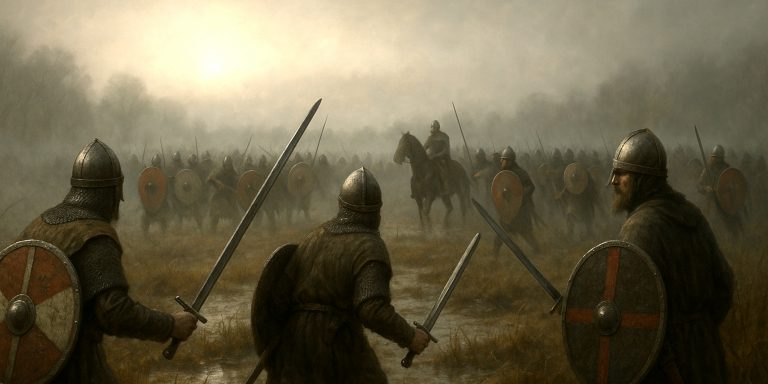
Infantry in the Napoleonic Wars fought in a landscape of smoke, thunder, and unrelenting drill. Victory depended on rhythm, cohesion, and the men who could stand their ground when the world seemed to collapse around them. Some units became legends because they held firm, others because they fought with a new kind of thinking.
S Tier – The Elite of the Age
These units combine first rate weapons, brutal discipline and a track record of doing impossible things under fire.
French Old Guard (Grenadiers and Chasseurs, 1804–1815)
Weapons:
- Charleville Model 1777 corrigé musket, .69 calibre
- Triangular socket bayonet
- French AN IX briquet sabre
Key battles: Austerlitz, Wagram, Dresden, Waterloo
Why they are S Tier:
Napoleon’s veterans, hand picked from the rest of the army. Their muskets were immaculate, their volleys controlled, and their bayonet charges were usually the final word in an argument. The briquet sabre was short, heavy and built for hacking through the wreckage of a broken line rather than elegant duelling.
When the Old Guard advanced, whole units on both sides adjusted their behaviour accordingly. That is power.
British Foot Guards (1st, Coldstream, 3rd Guards, 1803–1815)
Weapons:
- India pattern Brown Bess musket, .75 calibre
- Socket bayonet
- Pattern 1796 infantry officer’s sword
Key battles: Waterloo, Talavera, Salamanca
Why they are S Tier:
The Guards were the spine of Wellington’s army. Their party trick was not glamour, it was composure. Firing controlled volleys with the heavy Brown Bess, then calmly forming square under cavalry attack, they turned discipline into an art form.
The officer’s sword was light and elegant, and in the hands of a Guards officer it was no mere parade piece.
Russian Imperial Guard Infantry (1805–1815)
Weapons:
- Model 1805 Russian musket, about .70 calibre
- Long triangular bayonet
- Pallasch infantry sword, straight and heavy
Key battles: Borodino, Leipzig
Why they are S Tier:
The Russian Guard specialised in not dying when any sane unit would have broken. Their muskets were sturdy rather than refined, but they kept firing under appalling conditions. The pallasch had more in common with a cavalry sword, built for decisive thrusts instead of finesse.
At Borodino they stood in front of artillery fire that would have shaken most elites. They stayed put.
Prussian Grenadiers (Reformed Army, 1806–1815)
Weapons:
- Potzdam Model 1809 musket, .71 calibre
- Long Prussian bayonet
- Model 1809 short sabre
Key battles: Leipzig, Ligny, Waterloo
Why they are S Tier:
After the humiliation at Jena, Prussia rebuilt its army. The Grenadiers became the showcase of that effort. Their Potzdam muskets were decent, but it was the drill that made the difference. Volleys came on command, not on whim.
In close fighting the short sabre and bayonet were still very much in use. Reliable, aggressive and hard to shift.
Austrian Grenzers – Light Infantry (1790–1815)
Weapons:
- M1798 musket, .69 calibre
- Seitengewehr hunting sword
- Rifles in some companies
Key battles: Marengo, Aspern Essling, Wagram
Why they are S Tier:
Frontier troops from the edges of the Habsburg empire. They were hunters, raiders and scouts long before anyone handed them a uniform. Used properly, they skirmished in front of the main line, sniping officers and screening movements.
Their hunting swords and occasional rifles gave them a very different profile to regular line infantry. Less parade ground, more bushcraft.
British 95th Rifles (1800–1815)
Weapons:
- Baker Rifle, .625 calibre, rifled barrel
- Long sword bayonet, usable as a short sabre
- Pattern 1803 infantry officer’s sword
Key battles: Côa, Buçaco, Ciudad Rodrigo, Badajoz, Waterloo
Why they are S Tier:
The 95th fought like modern riflemen dropped into an earlier century. The Baker rifle was slower to reload than a musket, but if a rifleman pointed it at you from two hundred yards, you had a real problem. They aimed deliberately at officers, NCOs and gunners.
They moved in open order, used cover instinctively and treated the battlefield as a landscape rather than a parade square. The long sword bayonet turned them into surprisingly nasty close quarters fighters when skirmish lines crashed together.
If the Old Guard represent the high point of line infantry, the 95th represent the first real step towards what infantry would become.
A Tier – Professional Powerhouses
British Line Infantry
Weapons: Brown Bess musket, socket bayonet, Pattern 1796 spadroon
Key battles: Talavera (1809), Bussaco (1810), Albuera (1811), Salamanca (1812), Waterloo (1815)
Why they’re A Tier:
Their reputation rests on relentless discipline. British lines absorbed punishment, delivered controlled volleys, and formed square with frightening speed. Not as glamorous as the Guards, but the backbone of Wellington’s success.
French Voltigeurs
Weapons: Charleville musket, bayonet, sabre briquet
Key battles: Jena (1806), Austerlitz (1805 as light companies), Eylau (1807), Wagram (1809), Borodino (1812)
Why they’re A Tier:
Voltigeurs skirmished ahead of the main line, disrupting formations and targeting officers. Agile and bold, they softened the enemy before the decisive French attacks.
Polish Vistula Legion
Weapons: French pattern musket, bayonet, Polish sabre
Key battles: Somosierra (1808), Wagram (1809), Bautzen (1813), Leipzig (1813)
Why they’re A Tier:
Their charge at Somosierra became legend. The Vistula troops fought like men trying to win back a country, and they performed reliably in skirmish and line.
Russian Jaegers
Weapons: Short Jaeger rifle musket, bayonet, pallasch
Key battles: Eylau (1807), Friedland (1807), Borodino (1812), Maloyaroslavets (1812)
Why they’re A Tier:
Skirmishers with an instinct for irregular terrain. They didn’t match the precision of the 95th, but they understood how to disrupt enemy lines and bleed them in forests, ravines and villages.
Austrian Line Infantry
Weapons: M1798 musket, bayonet, infantry hanger sword
Key battles: Marengo (1800), Aspern-Essling (1809), Wagram (1809), Dresden (1813), Leipzig (1813)
Why they’re A Tier:
Better than their historical reputation suggests. Austrian battalions stood surprisingly firm in defensive fighting and inflicted real punishment when properly positioned.
B Tier – Solid and Battle Hardened
French Line Infantry
Weapons: Charleville musket, bayonet, sabre briquet
Key battles: Austerlitz (1805), Jena-Auerstädt (1806), Wagram (1809), Borodino (1812), Lützen (1813)
Why they’re B Tier:
The Grande Armée’s beating heart. Their best years were extraordinary, their worst stretched thin by constant losses.
Spanish Guerrilla Infantry
Weapons: Mixed muskets, captured French muskets, long knives, civilian sabres
Key battles: Bailén (1808), widespread ambush actions across Navarra, Aragón and La Mancha
Why they’re B Tier:
They strangled the French war effort in Spain. Not regular infantry, but their constant attacks forced Napoleon to scatter his armies.
Prussian Landwehr
Weapons: Mixed smoothbore muskets, bayonet, short sabre
Key battles: Großbeeren (1813), Dennewitz (1813), Leipzig (1813), Waterloo (1815)
Why they’re B Tier:
Citizen soldiers who found their footing quickly. Early battalions wavered, later ones held their ground with impressive stubbornness.
Neapolitan Infantry
Weapons: French pattern muskets, bayonet, short sabre
Key battles: Sacile (1809), Raab (1809), Leipzig (1813), Tolentino (1815)
Why they’re B Tier:
Better than the conscripts in D Tier, but still unreliable under sustained pressure. When given competent officers, they could surprise people.
Bavarian Infantry
Weapons: Brown Bess-type muskets, bayonet, infantry sabre
Key battles: Austerlitz (1805), Aspern-Essling (1809), Wagram (1809), Hanau (1813)
Why they’re B Tier:
Steady auxiliaries for the French. Bright uniforms, dependable musketry and respectable performance in coalition warfare.
C Tier – Brave But Uneven
Courage present, consistency lacking. Often let down by leadership, politics or poor equipment.
Dutch Line Infantry
Weapons: Mixed muskets, bayonet, short sword
At Waterloo some Dutch units fought stoutly, others wobbled. Given more time and stability, they might have climbed a tier.
Portuguese Line Infantry
Weapons: Brown Bess, bayonet, British pattern swords
Portugal’s army started the war in shambles. Under British training it became surprisingly capable. By the later Peninsular campaigns, Portuguese units could be trusted on a key section of the line.
Italian Infantry (Kingdom of Italy)
Weapons: French pattern musket, bayonet, short sabre
Brave in patches, pulled along by French command structures. Did useful work but rarely defined a battle.
Saxon Line Infantry
Weapons: Potzdam muskets, bayonets, hanger swords
Caught between Napoleon and the Coalition. Adequate troops who suffered from being on the wrong side at the wrong time more than once.
Swiss Infantry
Weapons: French muskets, bayonet, Swiss sabres
Professional and reliable in the service of several powers. Solid support troops, not headline grabbers.
D Tier – Strugglers and Stopgaps
These units sit at the bottom for a reason. Poor morale, bad equipment or woeful leadership, sometimes all three.
Neapolitan Conscripts
Barely trained, lightly motivated and armed with a mix of older muskets. The sort of unit generals quietly hoped would not have to stand on a key point of the field.
Hanoverian Militia
Given Brown Bess muskets and a quick shove towards the front line. Plenty of heart, not much preparation.
Westphalian Infantry
Troops of a French puppet state. Caught between loyalty to pay and loyalty to reality, and it showed.
Italian Provincial Militias
Fine for guarding depots and looking respectable on paper. In serious battle they contributed very little.
Early War Spanish Regular Infantry
Courage was never the problem. Leadership and organisation were. Without the guerrillas snapping at French heels, Spain’s regular army would probably have been ground under entirely.
Final Thoughts – What Actually Makes an Infantry Unit “S Tier”?
Looking across the list, the patterns are clear. The best units share three things:
- Relentless discipline – they stood when others broke.
- Weapons suited to their role – Old Guard muskets for crushing volleys, Baker rifles for patient killing at range, hunting swords and rifles for skirmish work.
- A clear tactical identity – whether that was the 95th Rifles prowling hedgerows or the Foot Guards standing like stone walls on a ridge.
In the end, the uniform colour and the cleverness of the drill manual mattered far less than this simple question:
When the world started to fall apart in smoke and cannon fire, did they keep doing their job?
The S tier units did. That is why we still talk about them.



